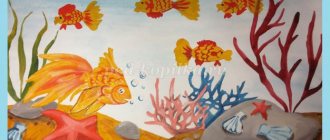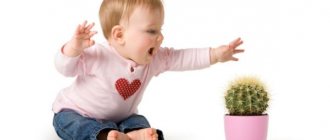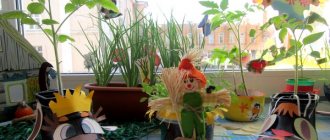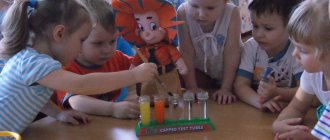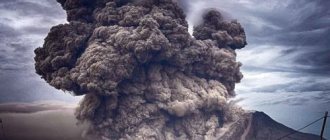MAGAZINE Preschooler.RF
Cognitive and research project in the junior group Topic: “We are little researchers”(long-term, practical-experimental)
Author of the project: teacher Shekunova O.V. MDOU Kindergarten No. 54 “Firebird” Moscow region, Podolsk
“The more a child has seen, heard and experienced, the more he knows and assimilated, the more elements of reality he has in his experience, the more significant and productive under other conditions his creative and research activity will be.” Lev Semenovich Vygotsky
Project Description
Experimentation is an effective method of understanding the patterns and phenomena of the surrounding world. Children's experimentation has enormous developmental potential. Modern children live in the era of informatization and computerization. In a rapidly changing life, a person is required not only to possess knowledge, but also, first of all, to be able to obtain this knowledge himself, operate with it, think independently, creatively.
All researchers of experimentation highlight the main feature of the cognitive activity of children: the child learns an object in the course of practical activities with it, the practical actions carried out by the child perform a cognitive, orientation-exploratory function, creating conditions in which the content of this object is revealed. In everyday life, children often experiment with various substances themselves, trying to learn something new. They disassemble toys, watch objects falling into the water (drowning or not drowning), testing metal objects with their tongues in severe frost, etc. But the danger of such “amateur activities” lies in the fact that the preschooler is not yet familiar with the laws of mixing substances and basic safety rules. An experiment, an experience specially organized by a teacher, is safe for the child and at the same time introduces him to the various properties of surrounding objects, the laws of life of nature and the need to take them into account in his own life.
Experimentation permeates all areas of children's activity. A preschool child is a researcher in himself, showing a keen interest in various types of research activities - in experimentation. Experiments help develop a child’s thinking, logic, and creativity, and allow them to clearly show the connections between living and nonliving things in nature.
This project represents the creation in a group of conditions for the development of cognitive activity in children and the formation in children of interest in the study of inanimate and living nature through children's experimentation. In the process of experimental activities, the following types of activities are used:
- gaming
- cognitive - research (experiments) and productive
— communicative (conversations, reading fiction)
All conversations and experiments are conducted taking into account the level of development and cognitive interests of children.
Work with children of this age group is aimed at creating the conditions necessary for sensory development during familiarization with the phenomena and objects of the surrounding world.
Relevance of the project
Childhood is a special period of formation of organs and systems and, above all, brain function, a period of active experimentation of the child with the objective world, without which the normal formation of the child’s mental abilities is impossible.
Everything that surrounds the baby - things that belong to adults, toys, animals, plants, water, sand and much more - arouses his interest.
He loves to explore new objects, experiment with various substances and materials: water, sand, snow, clay, paints, etc.
At the age of 3 years, children cannot yet operate with knowledge in verbal form, without relying on visual evidence, so in the vast majority of cases they do not understand the explanations of an adult and strive to establish all the connections on their own, through experiences and experiments.
Therefore, for children of this age, experimentation, along with play, is a leading activity. To do this, it is necessary to organize the work in such a way that children can repeat the experience shown to adults, they can observe, answer questions using the results of the experiments. In this form, the child masters experimentation as a type of activity and his actions are reproductive in nature.
Project object: formation of cognitive and research development, social and communicative development; speech development.
Project duration: November 2021 – June 2021
Project participants: children of primary preschool age, teachers, parents.
All experiments take place with the participation of game characters
Project goals:
- Development of ideas about the properties of substances, phenomena of the surrounding reality (water and air, light and shadow, magnetism, properties of sand, clay, stone, wood, plastic, metal and fabric); about the interaction of various substances when they are combined, about the influence of some objects on the properties of others.
Project objectives:
- Expand children's understanding of the physical properties of the world around them;
- Introduce the various properties of substances (hardness, softness, flowability, viscosity, buoyancy, solubility.);
- Develop children's understanding of certain environmental factors;
- Expand the understanding of human use of environmental factors: sun, earth, air, water, plants;
- Expand children's understanding of the importance of water and air in human life;
- Introduce children to the properties of soil and its constituent sand and clay;
- Develop an emotional and value-based attitude towards the world around you;
- To develop the intellectual emotions of children: to create conditions for the emergence of surprise in relation to observed phenomena, for awakening interest in solving assigned problems, for reflection, for the opportunity to rejoice at the discovery made.
Expected results:
- Bring children to a higher level of cognitive activity;
- To build self-confidence in children through the development of mental operations, creative prerequisites and, as a result, the development of personal growth and a sense of self-confidence and self-confidence in children;
- Enrich the subject-development environment in the group; To replenish the scientific and methodological base of the preschool educational institution in this area of work.
Stages:
1. Preparatory.
- Setting the goals and objectives of the project
- Determining the relevance and significance of the project
- Selection of methodological literature on the topic of children's experimentation in kindergarten and at home, for the implementation of the project (magazines, articles, abstracts)
- Development of long-term planning for experimental activities in the second junior group for the project “We are little researchers”
- Development of a plan for interaction with parents on experimental activities in the junior group for the project “We are little researchers”
- Selection of fiction for children
- Selection of didactic, role-playing and outdoor games on the topic.
2. Basic.
- Creation and arrangement of experimentation for successful project implementation
- Implementation of experimental activities with children on long-term planning
- Lesson planning, applications, working with parents.
3. Final.
- Create a subject-based development environment for children to independently experiment with natural and waste materials.
- Making a file cabinet for experimental activities with children
preschool age by age category
- Photo collage for parents
- Publication on educators' websites.
: containers of different sizes, measuring cups, cups, spoons, watering cans, molds, pebbles, sand, water, straws, soap, cocktail straws, funnels, objects made of different materials (wooden spools, rubber balls, toys, plastic buttons, metal objects etc.), plastic cups of different shapes, sizes, degrees of transparency.
: strings, plastic bags, balloons, pinwheels, kites, plumes, ribbons, flags, weather vanes, parachute.
Materials and equipment:
Magnifying glasses, a spoon, dishes, a toy, a box with fabric of different textures, characters in clothes made of paper and fabric, scraps of fabric, paper, ropes, rulers, an hourglass, a globe, a lamp, a flashlight, whisks, beaters, soap, brushes, sponges, pipettes, small things made of various materials (wood, plastic, metal), mills, corks, fluff and feathers, multi-colored clothespins; pebbles of different sizes
Containers: plastic jars, bottles, glasses of various shapes, sizes, measures, funnels, sieve, molds, spatulas.
Materials: natural (acorns, cones, seeds, shells, twigs, saw cuts, cereals, etc.), “waste” (corks, sticks, pieces of rubber hoses, cocktail straws, etc.), bean seeds, beans , peas; nut pits and shells; cotton wool, batting, padding polyester
Unstructured materials: sand, water, sawdust, wood shavings, fallen leaves, etc.
Forms of working with children:
Didactic games:
- "Find a Pair"
- "Find out the subject"
- "Taste it"
- "Find out by touch"
- "Recognize the sound"
Plot-role-playing games:
- "Laboratory"
- "Wind and Leaves"
- Game - experiment "Drawers"
Board-printed games:
- "Seasons"
- "Natural Phenomena"
- "What happens in nature"
- Cutting pictures “Collect plants”
- “What grows where?”
- Lotto "Flowers"
- "Signs of autumn, winter, spring, summer"
Outdoor games:
- "Sun and Rain"
- "Bubble"
- "My funny ringing ball"
- "What's hidden?"
- "Bumps"
Finger games
- “Rain” (Russian folk nursery rhyme)
- Oh you, rainbow-arc... (Russian folk nursery rhyme)
- "Snowball"
- "Sun"
- "Autumn leaves"
- "Ball"
- "Leaf Fall"
- "Snowflakes"
- “What to do after the rain?”
- "Rain"
- "EXERCISE WITH CORKS"
Poems and riddles about living and inanimate nature
The implementation of the set tasks is fully possible only if there is close interaction with the parents of the children.
Interaction with parents on basic experimentation:
Involving parents in replenishing attributes and materials.
Consultation:
“Organization of children's experimentation at home” , “Experimental activities in kindergarten. . " "Organization of children's experimentation at home" .
Memos for parents:
“Children's experimentation” , “What is possible and what is not” , “Signs of cognitive activity” , “On the organization of cognitive and research activities” “experimenting with water” and consultation for parents
Making a card index for visual propaganda of parents to conduct experiments and experiments with children at home.
Literature and sources
- E.A. Martynova, I.M. Suchkova. Organization of experimental activities for children 2-7 years old. Volgograd, 3rd edition, 2012
- O.V. Dybina, N.P. Razmanova, V.V. Shchetinina. “The unknown is near. Entertaining experiences and experiments for preschoolers . Moscow, 2005
- Internet resources.
- Nikolaeva S. N. “Methods of environmental education in kindergarten . – M. 2021
- Dybina O. V. “Classes on familiarization with the outside world in the second junior group of kindergarten” M.: Mozaika - Synthesis, 2014 (methodological manual)
- Experiences and experiments with substances and materials 3-4 years Federal State Educational Standard for Education. Card planning in preschool educational institutions.
| Next > |
Organization of educational and research activities
Cognitive and research activities in the younger group, according to the Federal State Educational Standard, should be aimed at improving and strengthening such important qualities in preschoolers as the desire to learn and conduct experiments.
Although the modern pedagogical system is not characterized by direct transfer of knowledge, this makes it possible to develop in children the necessary motivation to search for new knowledge using any methods.
Experiences and experiments are an effective method of teaching cognitive and research activities in the younger group
The organization of such activities is primarily aimed at encouraging curiosity, finding answers to any questions and increasing attentiveness as such . In this case, knowledge is manifested both in independent studies and during training with a teacher.
This ability to pose a clear question in relation to a little-studied object or subject and then find an answer determines the high level of development of the child’s intellect and psyche. Simply put, children are real researchers who need help finding a solution to a problem.
Techniques used
Cognitive and research activities in the younger group are characterized by the presence of various methods and techniques that can significantly simplify the learning process.
The most popular and used in practice are:
- Heuristic method. In this case, the teacher creates a certain problem in order to motivate the child. Thus, it is possible to form a sense of group cohesion in the preschooler in order to find the answer to a particular problem and activate intellectual abilities to analyze the problem. Improving speech, research and inquisitive skills is facilitated by various conversations where the problem is discussed. The teacher must determine the question based on the child’s level of knowledge and also take into account the age of the group. At the same time, the teacher forms clarifying and leading questions in order to lead the preschooler in the right direction. Within the junior group, the duration of such a conversation is from 10 to 15 minutes.
- Observation. Such a process is most often organized within a certain room in a preschool educational institution or on the street, where the perception of various objects or phenomena comprehensively develops the child’s auditory and visual abilities. Those explorations that are carried out during a walk better immerse the preschooler in the world around him due to a greater number of images, smells, colors or sounds.
- Experiments and conducting experiments. Along with the game process, experiments are considered one of the main forms of activity of a preschooler. Thus, when carrying out basic research on objects in kindergarten, the child acquires an important understanding of how they work and begins to see the basic properties and features of objects. Preschoolers with great enthusiasm and pleasure conduct experiments with substances that they already know - clay, sand, plants. Such a research process best creates a desire to conduct independent experiments. This method especially develops concentration, observation, discipline, and also contributes to the development of a friendly atmosphere in the team.
- Project activities . This type of work is aimed at the research activity of preschoolers and teachers, and in some cases, parents. In this case, both the child’s thinking and creative skills are used. The teacher must properly motivate the student to make independent observations and experiments, helping the preschooler only when particularly necessary.
- Technologies using the TRIZ method . It consists of solving electoral tasks, thanks to which the child can independently build algorithms and action plans in order to solve this or that problem. Such a technological solution in kindergarten is often used in a playful way, which allows for more effective interaction with students. The teacher builds fairy-tale plots around learning, which gives the preschooler the opportunity to learn together with their favorite toys or characters from fairy tales and cartoons.
During experiential learning, the child learns the important analysis of information . In this way, a preschooler can learn a new skill by comparing its advantages and disadvantages, and also find more effective teaching methods.
